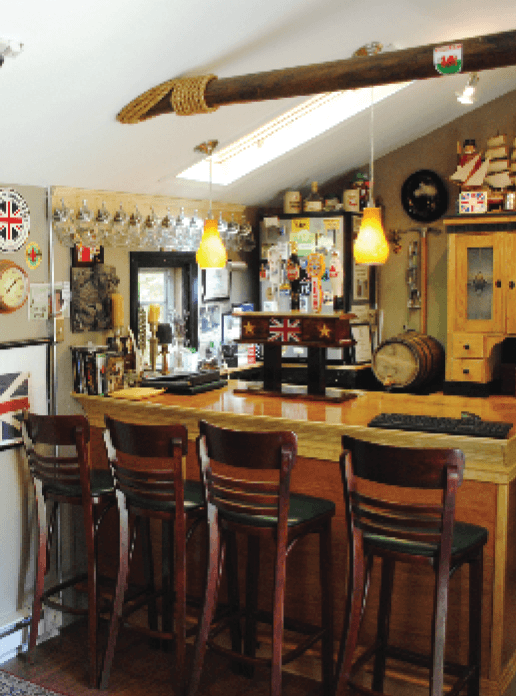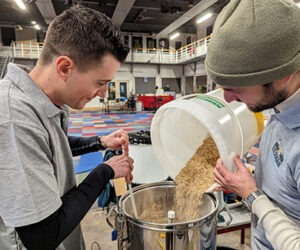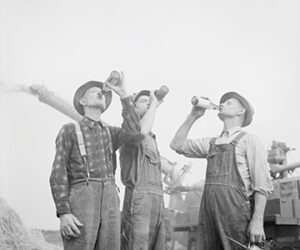Historical Homebrew – HammerSmith Ales
The history of the city of Bethlehem, Pennsylvania is inextricably linked with brewing. At some city festivals, for instance, you might witness the resurrection of 19th-century Moravian city brewer-turned-mayor Johann Sebastian Goundie. In reality, the man behind the kettle is Christopher Bowen, a modern day brewing Renaissance man. A prodigious homebrewer, Bowen has become a nucleus of activity in the culture of historical brewing. Here is a man who traded his old career in financial planning for a much sweeter job title: beer historian and adventurist.
These days Bowen digs through beer books instead of spreadsheets. From his home shed setup, the HammerSmith Brewery and Alehouse, Bowen’s interests evolved around English-style beers, especially those from the Victorian and Edwardian eras of the 19th and early 20th centuries. During his eight years’ experience with homebrewing, Bowen has acquired a wealth of knowledge and experience in recreating old beers. In addition to recreating recipes, he has accrued several samples of the originals as well. “I probably have one of the largest collections in the US regarding old beers,” Bowen said. “It’s not uncommon that I get to drink an 80- or 100-year-old beer to this day.”
Bowen is just one face in a movement of brewers, both at home and professional, who are looking to the past for inspiration. There are many ways to simply draw ideas from these classic beers such as using known techniques and ingredients such as amber malt, brown malt, or a hop variety with a historical presence in the area. “For most homebrewers there’s always a problem with recreating anything from the past,” Bowen explained. “We weren’t there, so we don’t know exactly what was available and what was involved.”
The truly dedicated, creative, or just plain adventuresome brewers delve further, trying to recreate as accurately as possible the conditions under which the beer was originally made. This is the quest of Bowen’s work. “It’s where you say ‘I’m going to replicate the water from this town, look at the brewing records, and get malt that is the same as it was 100 years ago,’” he said.
So when Bowen suits up in costume or brews at home, he takes it to the next level. To accommodate his brewing styles and brew volume, he works with several different homebreweries. One, modeled after an 18th-century brewery, utilizes a copper pot and a couple of whiskey barrels. Another, factoring in the technological changes in the 19th century, is a steam-powered system comprised entirely of copper. When not in character, Bowen uses the gleaming mechanized system he built from scratch — enough to make any homebrewer drool — that is housed in his home shed. This setup has been featured in the New York Times and was called “America’s Coolest Homebrewery” in 2010 by Forbes magazine.
Bowen encourages homebrewers to put extra effort into selecting ingredients. When obtaining malt for a 200-year-old recipe, for example, Bowen chooses Thomas Fawcett, a company that has operated on the same site in Castleford, England, since 1809. “In creating a beer from 1810, you want to get malt from a company that was around and making it during that time,” Bowen explained. As an official Bethlehem brewing historian, Bowen has access to local recipes and tasting notes from travelers — preserved from centuries ago — that allow him to place his brew in its historical context.
Some ingredients are hard to come by; either they just aren’t in demand or they are too expensive to produce. In researching an old porter, for instance, you might need brown malt. Not widely available commercially, brown malt was historically used in some porters and dark ales. Instead of compromising on a substitute ingredient, a brewer can make his or her own. Specialty malts can be achieved by kilning or roasting green or finished malts. Brown malt can be made by roasting pale malt at a high temperature for a short amount of time, then spreading it out and cooling it quickly to prevent over-darkening. A more traditional method would be to roast un-kilned malt over a wood fire, which adds smokiness.
Some traditional processes are more involved. For example, historical recipes might call for an 18th century sugar called essentia bina. This is made by diluting muscovado sugar, boiling it, setting the kettle on fire for several minutes, and rehydrating. It’s a complex sugar that has some licorice flavor in it alongside peat smokiness. Centuries ago it was very commonly used to add color and flavor to porters in London breweries. “I once had to make 19 pounds of essentia bina for a commercial recipe, which was very difficult,” Bowen laughed, “so it’s probably best left to the small homebrewer to make the closest replications.”
Fortunately, resources are growing for those with the hunger to try making historical beers. One such resource, Mitch Steele of Stone Brewing Co.’s book on IPAs published last year, talks quite a bit about the ale’s history and brewing historical versions. Then there are Bowen’s direct inspirations like Ron Pattinson — the prominent historian, author and blogger for his site: Shut Up About Barclay Perkins — and Martyn Cornell, a beer historian who blogs on Zythophile (http://zythophile.wordpress.com/).
The old beer obsession has also inspired new entries in the craft beer industry. Notable projects include the Once Upon a Time series by the Pretty Things Beer and Ale Project, Dogfish Head’s Ancient Ales series, and Fuller’s Past Masters line. Looking to the past could lead the next wave of innovation, but as Bowen shows, homebrewers are ideally positioned for the work.
“Beer is more of a moving target than most people think,” he said. “Beer made back then was a more laborsome technique — blending, aging — that just doesn’t make commercial sense anymore. But in homebrewing there are people taking on these challenges. Homebrewers are becoming interested in brewing the beers of their great-great-grandfathers.”
For Bowen, the brewing adventure is ongoing. He recently traveled to the Canadian Arctic in an attempt to recreate Allsopp’s Arctic Ale (a high-alcohol, hoppy beer first brewed in 1852 to sustain a team of Arctic explorers led by Sir Edward Belcher), which is being turned into a film. The documentary, called Arctic Alchemy, is scheduled for release later this year.
He is also looking forward to the future of historical brewing. “Most people are interested in their own history,” he said. “I think the nature of homebrewing is that this is a craft that is part of the history of mankind, that it’s evolved with us.”
Bowen entertains friends and beer drinkers in his homebrewing shed, which features a draft bar setup with a true English pub feel.
HammerSmith Ales English IPA
(5 gallons/19 L, all-grain)
OG = 1.058 FG = 1.010
IBU = 54 SRM = 11 ABV = 6.2%
This is a recipe that won a gold medal and best of show at the Great American Beer Festival in the ProAM catagory, a silver medal at the AHA regional and a gold medal at the Kona Beer Festival. It is based off of a 19th century recipe from Samuel Allsopp and Sons LTD, circa 1860s. English brewers used tons of American hops in many beers during the 19th and 20th centuries. This was dry hopped with Chinook, but other than that I used all East Kent Goldings. Chinook is a distantly related cultivar of the Petham Golding.
Ingredients
10.5 lbs. (4.8 kg) British 2-row pale malt
14.4 oz. (0.41 kg) crystal malt (60 °L)
6.4 oz. (0.18 kg) amber malt
5.4 oz. (0.15 kg) torrified wheat
10 AAU East Kent Golding hops (2 oz./56 g at 5% alpha acids) (60 min.)
2.5 AAU East Kent Golding hops (0.5 oz./14 g at 5% alpha acids) (30 min.)
7.5 AAU East Kent Golding hops (1.5 oz./42 g at 5% alpha acids) (10 min.)
1.25 oz. Chinook hops (dry hops)
1 tablet Whirfloc (15 mins.)
1 tsp. yeast nutrients (15 mins.)
Wyeast 1275 (Thames Valley Ale) or White Labs WLP023 (Burton Ale) yeast
2/3 cup corn sugar (if priming)
Step by Step
This is a single infusion mash. Target mash temperature is 152 °F (67 °C) mixing grains with 3.6 gallons (14 L) of strike water. Raise mash to 168 °F (76 °C) and begin lautering. Boil for 60 minutes adding the bittering hops at times indicated in the ingredients list. Add the Whirfloc tablet and yeast nutrients when 15 minutes remain in the boil. After the boil is finished, chill the wort to 67 °F (19 °C) and transfer to a sanitized fermentation vessel. Ferment at 67 °F (19 °C). Add the final addition of hops and store the beer an additional week at 58 °F (14 °C). Your beer is now ready to rack into a keg, or bottles along with the priming sugar.





